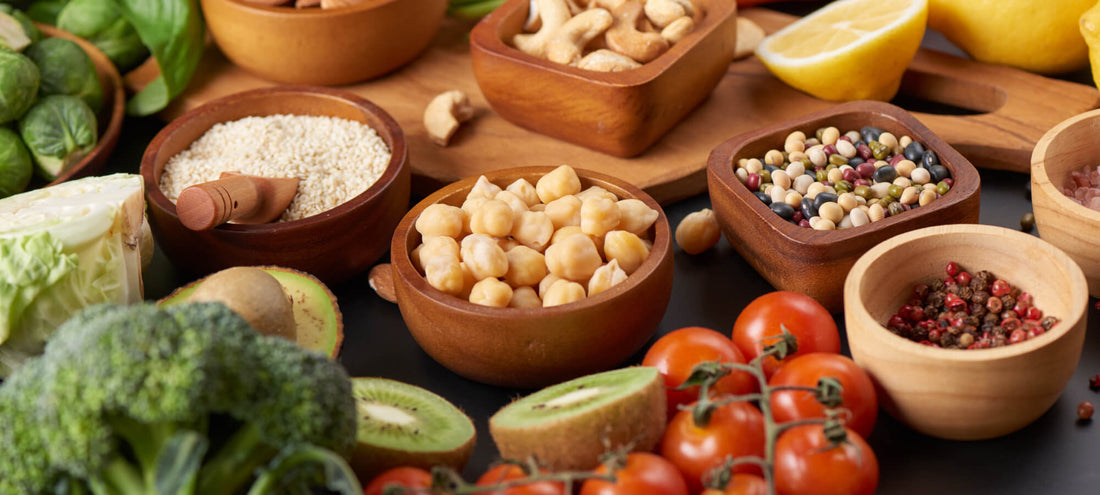
7 High Protein Foods to Boost Nutrition
Share
Protein is a vital nutrient responsible for everything in the body, from muscles and bones to skin and blood. They are the building blocks of enzymes, core components of hemoglobin that act as oxygen transporters and support the immune system (1). A common concern for vegetarian diets is insufficient protein.
Protein Requirements
Protein requirements are not the same for everyone and depend on various factors like body weight, muscle mass, age, and physical activity.
The Indian Council of Medical Research (ICMR) guidelines recommend a daily protein intake of 0.8 to 1.0 grams per kg of body weight to meet the basic nutritional requirements (2).
Did You Know? The 27th of February is marked as National Protein Day.
Impact of Low Protein Diets
Lack of protein and excessive intake of refined flour and sugar are the major causes of obesity and related health issues. Thus, rebalancing the macronutrients by increasing the intake of protein, whole grains, and pulses is beneficial for overall health. Additionally, plant-based protein comes with a diverse range of other nutrients like vitamins, minerals, fiber, and antioxidants, making it a wholesome food choice, making it the ideal protein rich food for weight loss.
However, the most common concern amongst vegetarian and vegan diets is the adequacy of protein intake. The good news is that they can meet their daily protein intake by including a diverse range of plant-based foods.
Tasty Ways to Meet Your Protein Goals
Here are some protein rich food items to help you meet your daily protein requirements.
1.Prolicious Products:

Prolicious products are made by combining cereals, legumes, and pulses, ensuring the correct balance of protein, fibre, and carbohydrates. From snacks to meals, Prolicious has got you covered with various options to fulfill your daily protein needs. The presence of plant-based proteins makes them inherently rich in fibre and various micronutrients. Some of the millet-based products, along with a combination of high protein, make them nutrient-dense choices.
1 serving of Prolicious khakhras and thins, which are ready to eat, provides 4-6g of protein. Prolicious premixes and millet-based products provide 10–20 g of protein.
2. Beans and Legumes:

Beans and legumes are an inexpensive, versatile, and flavorful source of plant-based protein foods for weight loss and micronutrients. From kidney beans to black beans to pinto beans, they come in a wide range and are highly nutritious, making them the best substitute for animal products. Their protein content is comparable to that of meat. (3) From refreshing salads to hummus, dips, curries, and soup, you can include them in various ways in your daily diet.
A ½ cup serving of cooked beans provides up to 25 g of protein.
3. Lentils and Pulses:

Whole and split pulses, a staple food in most Indian diets, are a major source of protein. Additionally, they offer a range of essential nutrients like fiber, iron, B-vitamins, folate, etc., making them a nutrient-dense option to include in your daily diet. They are incredibly versatile and can be incorporated in various forms, such as soups, salads, dips, wraps, curries, etc.
1 cup of cooked lentils can provide 6–8 g of protein.
4.Soy:
Soy has been a staple of traditional Asian cuisine for thousands of years. The high protein and low carbohydrate content of soy sets it apart from other legumes and makes it distinctive as a source of high-quality proteins. Soybeans are also high in critical nutrients such as unsaturated fatty acids, B vitamins, fiber, iron, calcium, zinc, and a variety of bioactive substances, making them a wholesome food choice. (4)
1 cup of cooked soybeans provides 8–10 grams of protein.
5.Tofu:

Tofu, made from soybeans, is a widely cherished food in Asian cuisine. Tofu is a natural, nourishing, and excellent source of nonanimal protein food for weight loss in the diet of vegetarians. It is commonly used as a low-fat replacement for paneer. Its subtle flavor and neutral taste make it a versatile ingredient that can be included in a multitude of recipes.
100g of tofu provides 8–10g of protein.
6.Tempeh:

Tempeh made by fermenting legumes or soybeans is famous worldwide due to its high protein and probiotic properties. The fermentation process increases the nutritional quality of protein by reducing the antinutritional composition and increasing B-vitamin and overall protein digestibility. (5) Add them to soups, salads, sandwiches, sushi, and wraps to enhance the protein intake.
1 cup of tempeh provides 6–8 g of protein.
7. Nuts and Nut Butter:

Nuts, a treasure trove of healthy fats, are a significant source of plant-based protein. The combination of protein, fats, and fiber is what makes them a satiating snack option. They also provide a range of vital nutrients like B-vitamins, magnesium, and potassium. These nutritional powerhouses are extremely versatile and adaptable. Add it to your salads, smoothies, oat meals, and bakery items to enhance the overall protein content, or simply spread a tablespoon of nut butter over your favorite fruits.
1 tablespoon of nuts provides 5-7 grams of protein.
8.Green Peas:

The small, spherical seeds that come from pods known as “garden peas” or “green peas” are not vegetables but a part of the legume family. They are great sources of plant protein and are extremely filling due to their fiber content. (6) Add it to your parathas, fried rice, pulao, and biryanis, or make a sabji, tikki, or dip to enhance your meal's flavor and nutritional value.
1/3 cup of cooked green peas provides 4-6g of protein.
Conclusion
Protein deficiencies are fairly uncommon in vegetarian and vegan diets, if meals are planned and well-balanced. However, if you are looking to add more diversity, vary your protein sources, the above-mentioned vegetarian protein foods can be considered.
Pre-planned meals promote the intake of variety of nutrients, in addition to being protein rich. Nutritionists recommend adding one protein rich ingredient to all meals and snacks for better health, lesser cravings, and more satiety.
References:
- https://www.hsph.harvard.edu/nutritionsource/what-should-you-eat/protein/
- https://main.icmr.nic.in/sites/default/files/ICMRINNEWS_22to28_February_2020.pdf
- https://www.mdpi.com/2072-6643/10/1/43
- https://www.ncbi.nlm.nih.gov/pmc/articles/PMC8619156/
- https://www.healthline.com/nutrition/green-peas-are-healthy#TOC_TITLE_HDR_2


